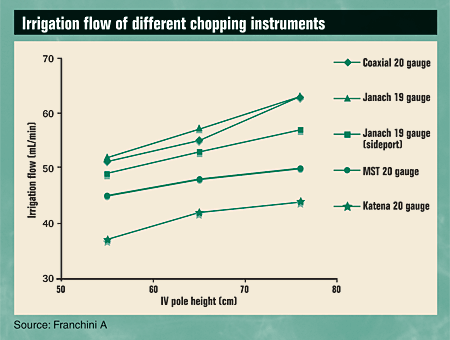Surgeons discuss ideal MICS irrigating choppers
At the ESCRS meeting, three surgeons said their choice of chopper depends on diameter, shape, length and angulation.
Click Here to Manage Email Alerts
Irrigating choppers must have sufficient cutting power and good maneuverability for easy insertion and manipulation of lens fragments. They also must be able to guarantee an adequate, constant flow without causing turbulence in the anterior chamber. So far, several instruments have been designed to achieve these goals and are on the market.
“When in 1993 I performed my first bimanual procedure using the erbium laser, I designed an 18-gauge front-opening irrigating chopper. However, I found that having all the irrigation at the same point, especially if working with lasers, could cause increased turbulence in the anterior chamber with consequently more chatter and less holdability and followability,” Alessandro Franchini, MD. “Therefore, I designed a new chopper with lateral openings.”
Although this seemed to be a good solution for laser microincision surgery, the issue was revisited a few years later with the introduction of low-ultrasound microincision techniques. This advanced phaco technology was able to provide a faster, more efficient procedure through a small incision.
“An irrigating chopper with lateral openings produces less turbulence but a lower irrigation flow than an open-ended chopper. The introduction of the new phaco machines, with less phaco time and revulsive forces, has determined an increase in holdability and followability, which neutralizes the effects of the turbulence generated by the irrigation flow. Therefore, we can now return to the greater efficiency of front-opening irrigating choppers,” Dr. Franchini said.
 |
Convert between techniques
Peter J. de Lint, MD, and Sabah Meriwani, MD, developed their own instruments for MICS, one for horizontal chopping and one for vertical.
“We tested 14 different irrigating choppers but were not totally happy with any of them. Mostly we found an inadequate irrigation flow. We also found that horizontal choppers have an insufficient tip length and that most choppers have narrow blades that make it difficult to convert to divide-and-conquer,” Dr. de Lint said.
Dr. de Lint concluded that front-opening irrigating choppers are better because they have a higher flow capacity and keep a stable anterior chamber.
Horizontal, vertical choppers
The Alkmaar horizontal irrigating chopper (E. Janach srl) has a square-shaped shaft with a spherical ending that allows for back- and side-chopping by right- and left-handed surgeons. The 1.9-mm length of the shaft makes it easy to get around the equator in a horizontal motion, Dr. de Lint said.
“Horizontal chopping is suitable for the majority of cataracts, cortical or nuclear,” Dr. Meriwani said. “The nucleus is impaled by the phaco tip, the chopper is passed around the equator and pulled toward the phaco tip. The same maneuver is repeated to divide the hemi-nuclei.”
The vertical version of the chopper has a 1.7-mm spade-shaped blade, which also allows for side chopping by right- and left-handed surgeons.
“The vertical instrument is more suitable for hard nuclei or in case of small pupils or small capsulorrhexis,” Dr. Meriwani said. “The nuclear fracture is achieved by vertical insertion of the chopper tip in the center of the lens, followed by horizontal separation of the hemi-nuclei.”
According to Fernando Araújo-Gomes, MD, the use of an elliptical-shaped frontal irrigating chopper provides a better fit to the incision, less leakage through the opening and consequently more stability in the anterior chamber.
Dr. Araújo-Gomes said that when a round instrument is inserted through an incision, it produces an oval opening with an empty space on either side of the instrument. With coaxial phaco, the sleeve fills in these side pockets. But in bimanual phaco it leaves too much empty space for leakage, and then there is a need for an excessive bottle height and a high flow rate.
The A. Gomes frontal irrigating chopper (Buerki Innomed) is a 20-gauge oval instrument that has been successfully used in 250 bimanual ultra-small-incision cataract surgery procedures.
For Your Information:
- Alessandro Franchini, MD, can be reached Istituto di Oculistica, Università di Firenze, Viale Morgagni 85, 50134 Firenze, Italy; +39-055-411765; fax: +39-055-4377749; e-mail: oculist@unifi.it. Dr. Franchini is a paid consultant for Advanced Medical Optics.
- Peter J. de Lint, MD, can be reached at Wilhelminalaan 12, 1815 JD Alkmaar, The Netherlands; +31-725483208; e-mail: pjdelint@mca.nl. Dr. de Lint and Sabah Meriwani, MD, have no direct financial interest in the products mentioned in this article, nor are they paid consultants for any companies mentioned.
- Fernando Araújo-Gomes, MD, can be reached at Clinica de Santo Antonio, Av. Hospitais Civis de Lisboa 8, 2720-275 Amadora, Portugal; +351-214952541; fax: +351-214961551. Dr. Araújo-Gomes has no direct financial interest in the products mentioned in this article, nor is he a paid consultant for any companies mentioned.
- E. Janach srl can be reached at Via Borgo Vico, 35 - 22100 Como, Italy; +39-031-574088; fax: +39-031-572055; Web site: www.janach.it.
- Buerki Innomed can be reached at Wisenstrasse 1, CH-9442 Berneck, Switzerland; +41-71-744-88-66; fax: +41-71-744-88-67; Web site: http://www.innomed.ch.
- Michela Cimberle is an OSN Correspondent based in Treviso, Italy.
